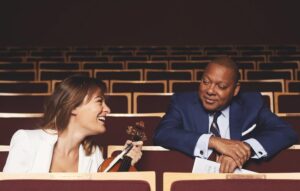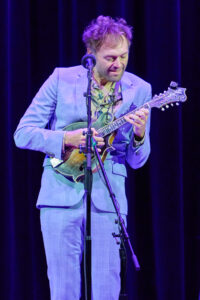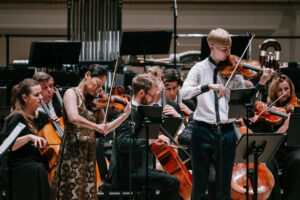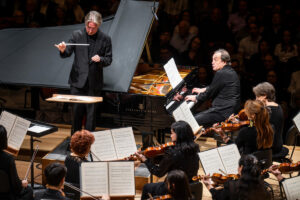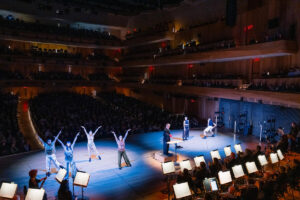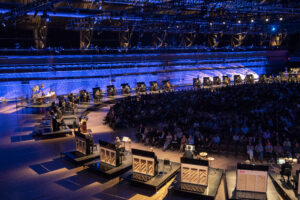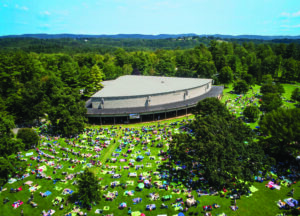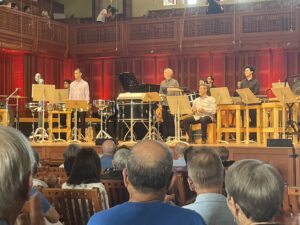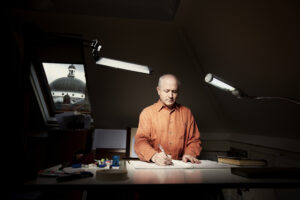
Pierre-Laurent Aimard in Recital
92nd Street Y
November 19, 2025
Published in Sequenza 21
NEW YORK – Pianist Pierre-Laurant Aimard has had a long and fruitful collaboration with the composer George Benjamin. Aimard’s recital program this past Wednesday at the 92nd Street Y was conceived and built around two of Benjamin’s pieces, Shadowlines, a group of six canons for solo piano, and Divisions, a new four-hand piece on which the composer joined him for this New York premiere.
The other programmed works were meant to complement the Benjamin pieces and proved to be strong foils for them. Nikolai Obukhov (1892-1954), a Russian who, during the Bolshevik Revolution, resettled in Paris, is an esoteric and intriguing figure. He created an alternate version of music notation, developed decidedly different methodologies for total chromaticism, and engaged in a kind of mystical masochism: he used his own blood to correct compositions, mirroring artistic travails to the sufferings of Christ. Eccentricities aside, Obukhov’s Révélation (1915), performed with great intensity by Aimard, is highly engaging, a tantalizing glimpse of an underserved oeuvre.
Aimard is regarded as one of the most eloquent interpreters of the music of Pierre Boulez (1925-2016). Indeed, he was heard just last month performing selections from Douze Notations (1945) with the New York Philharmonic. Here he played the composer’s Piano Sonata No. 1 (1946), another prodigious piece from the nascency of the postwar avant-garde. Unlike the second sonata, in which Boulez suggested he “blew up the form,” this piece keeps a toehold in the tradition of the genre, all the while testing its limits with post-tonal formations and elliptical phrasing. It is, like all the other works on the program, considerably demanding.

Like Boulez, Benjamin studied with Olivier Messiaen, and the two were also connected by collaborations in performance. Shadowlines may not entirely blow up classical tradition – it is, after all, composed of a half dozen canons – but Benjamin shares with Boulez an affinity for post-tonal writing and herculean virtuosity. And like the Notations, each section takes on an entirely different character, with mercurial shifts of register, gesture, and density.
The second half featured Le Tombeau de Couperin (1919) by Maurice Ravel (1875-1937). The Couperin in question, in a line of distinguished composers, is François (1668-1733), whose elegant suites formed a template for Ravel’s own tombeau, this one commemorating friends of the composer who had been killed in World War I. If listeners might reasonably expect the piece to have a mournful cast, they are likely to be surprised by the ebullience of much of it. Most of the movements of Le Tombeau de Couperin have been orchestrated, and in the piano version one can hear the vivid colorations that may have helped to inspire their being recast for larger forces.
Divisions was finished just this year, and when crafting the work Benjamin clearly had his collaboration onstage with Aimard in mind. Four-hands music has a choreographic element to it: how do two pairs of paws operate without overcrowding among 88 keys? Is there enough “elbow room?” Benjamin writes parts that take risks in this regard, with the primo (right side) player occasionally reaching over an active secondo (left side) player to add a bass note to the proceedings. Similarly, the secondo invades primo territory for alto register countermelodies and widely dispersed harmonies. In Divisions, one can hear affinities to all of the other pieces on the program – kudos for curating – with use of dissonance alongside counterpoint, dance-like rhythms alongside angular gestures – in a mélange of materials. Benjamin and Aimard have been touring this program to a number of cities. One hopes this serves double duty as rehearsals for a forthcoming recording.
-Christian Carey
